Across a brief 10-day period covering mid to late July, the United Arab Emirates, China, and the United States each launched their own mission to explore Mars. For the UAE and China, it is their first solo attempt to reach the Red Planet, whereas the U.S. is continuing to build upon a legacy of success at Mars. All three spacecraft are expected to reach the planet in February of 2021.
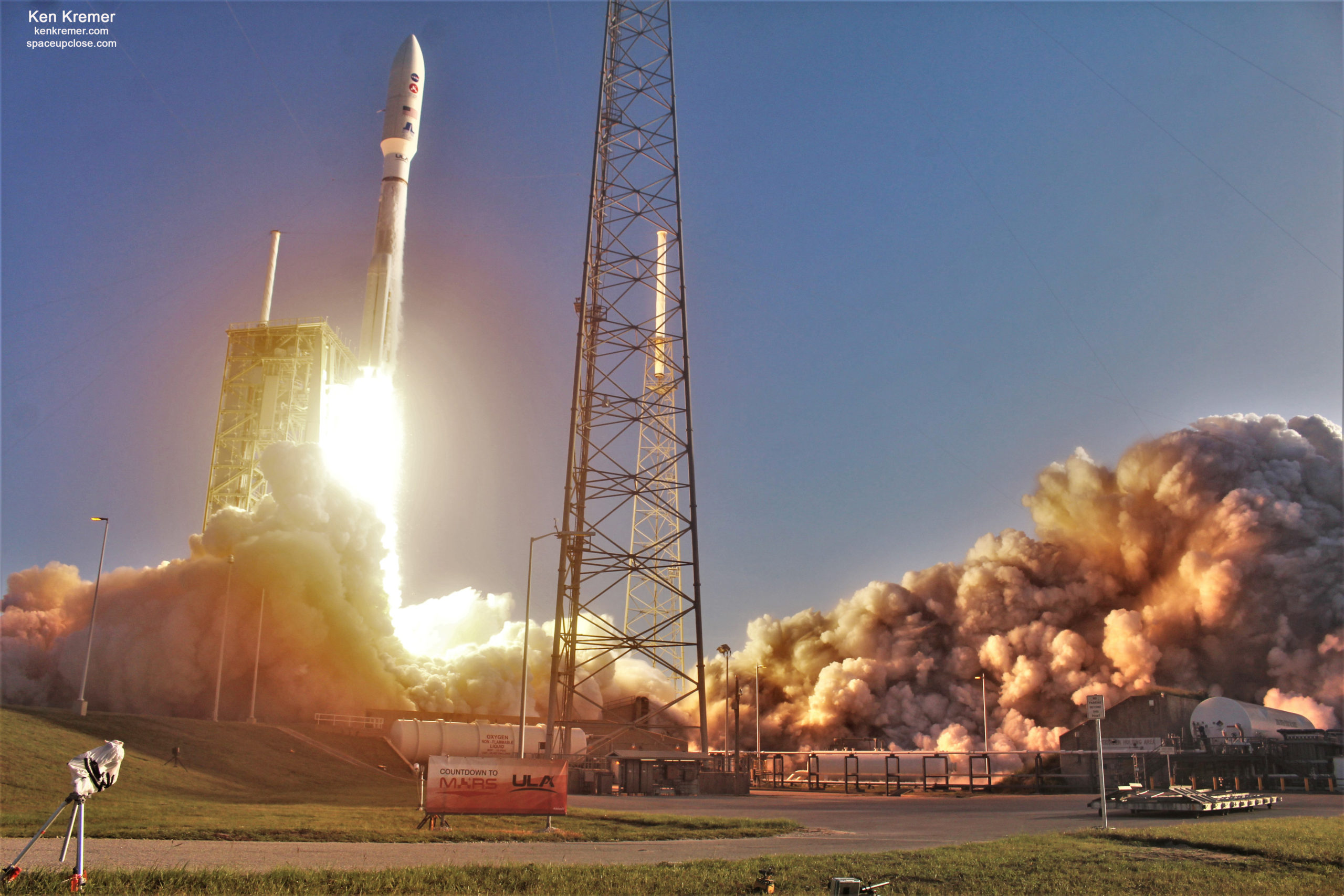
NASA’s Mars 2020 Perseverance rover goes in search of life
NASA’s $2.7 Billion Mars 2020 Perseverance Rover launched the morning of July 30, 2020, on a 300 million mile (500 million km) interplanetary journey atop a powerful United Launch Alliance Atlas V rocket under picture-perfect skies from the Florida Space Coast. The rover is expected to land upon an ancient lake bed on a bold mission in search of signs of past microbial life, and to collect pristine samples to send back to Earth for the first time ever as part of a future mission.
Perseverance is humanity’s most sophisticated rover ever launched and the mission includes the daring Ingenuity Mars Helicopter rotorcraft which will attempt the first-ever powered flight on another planet.
Furthermore, it definitively starts the ‘Holy Grail’ goal of Mars Sample Return – sought after by scientists for decades to retrieve soil samples and bring them back to Earth for the best possible analysis – to help determine if life ever existed past or present.
Under clear blue sunshine drenched skies, the car-sized Perseverance Mars 2020 rover lifted off right on time at 7:50 a.m. EDT (1150 GMT) aboard a 19-story-tall ULA Atlas V 541 rocket from Space Launch Complex 41 on Cape Canaveral Air Force Station, Florida.
Perseverance launched amidst the global coronavirus pandemic causing severe hardships across the globe and nearly two weeks of delays from the originally planned mid-July launch date. But the name took on significant added meaning shortly after it was announced and served as a call to action for all involved and all humanity to fight on and ‘persevere’ against the worldwide COVID-19 public health crisis.
The Atlas V produced a massive and magnificent billowing vapor trail to space – yielding a spectacular sight for all those hordes of lucky spectators.
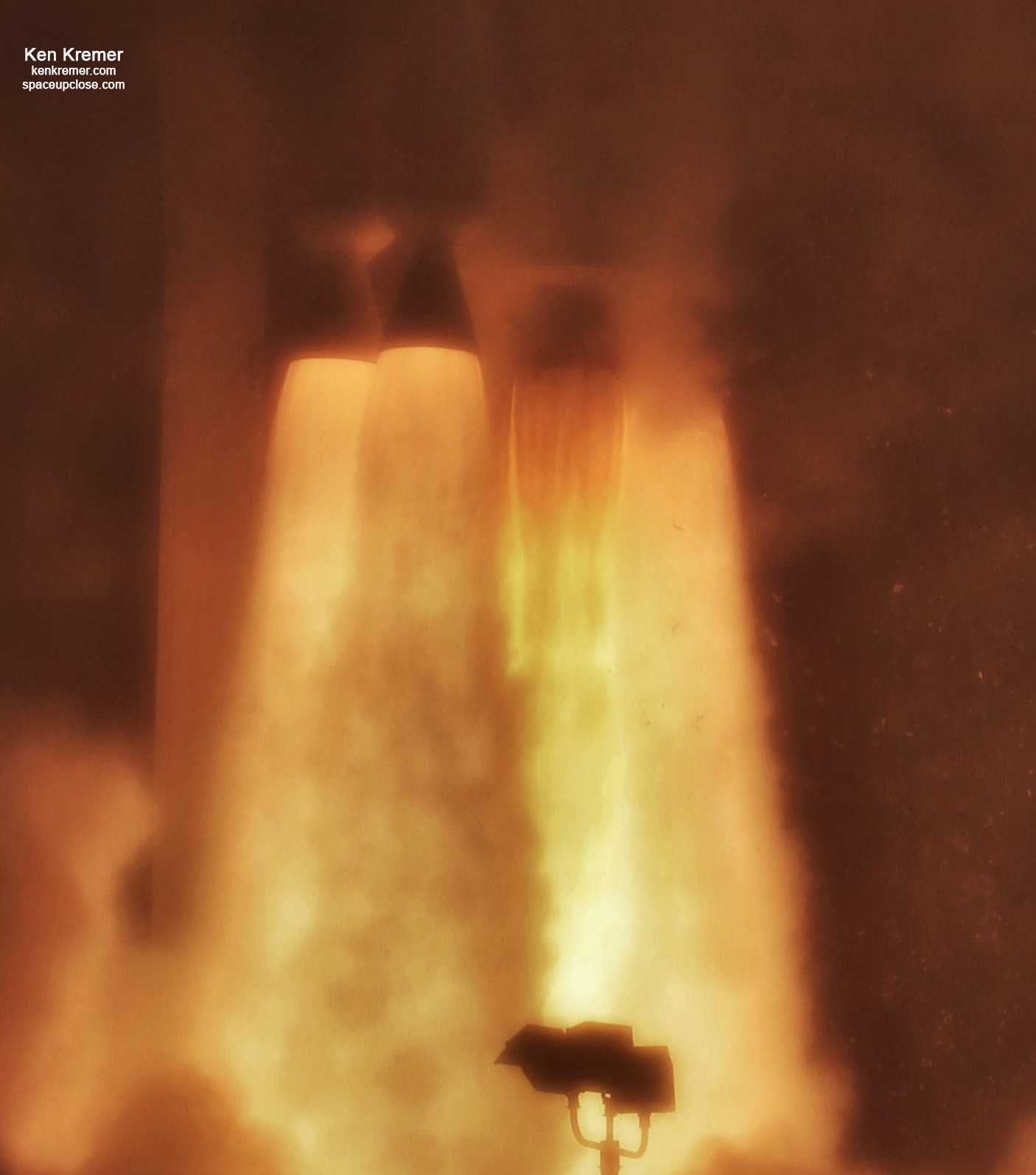
“With the launch of Perseverance, we begin another historic mission of exploration,” said NASA Administrator Jim Bridenstine. “This amazing explorer’s journey has already required the very best from all of us to get it to launch through these challenging times. Now we can look forward to its incredible science and to bringing samples of Mars home even as we advance human missions to the Red Planet. As a mission, as an agency, and as a country, we will persevere.”
https://x.com/NASA/status/1288873450984046597
The Perseverance Mars 2020 mission will search for signs of past microbial life, characterize Mars’ climate and geology, collect samples for a future return to Earth, and pave the way for human exploration of the Red Planet.
Ingenuity, a twin-rotor, solar-powered helicopter attached to the belly of the rover, will become the first aircraft to fly on another world.
https://x.com/NASAPersevere/status/1288897109781966848
The 191 foot tall (58 m) ULA Atlas V performed flawlessly roaring off pad 41 generating 2.3 million pounds of liftoff thrust in its second most powerful configuration – the Atlas V 541.
“I could not be more proud and more humbled by the courage and dedication of my launch team.” Tory Bruno, President & CEO of @ULALaunch, explains how the spacecraft was kept clean and powered leading up to the #CountdownToMars— despite the challenges of a global pandemic:,” NASA tweeted.
https://x.com/NASA/status/1288868934687612930
The ULA Atlas V successfully delivered the Perseverance Mars 2020 mission to a hyperbolic orbit and deep space trajectory propelling the 9,000-pound (4.1-metric ton) spacecraft to almost 25,000 MPH (11 km/sec) to escape the pull of Earth’s gravity and break free of the Home Planet for a 1 way trip to the Red Planet.
The 541 configuration features a RUAG made 5-meter (17 ft) diameter payload fairing (PLF) encapsulating the rover and upper stage, 4 solid rocket boosters, and a single-engine Centaur upper stage.
The Atlas first stage was powered by the Russian made RD AMROSS RD-180 engine fueled by cryogenic liquid oxygen (LOX) and highly refined RP-1 kerosene and four strap-on AJ-60A SRBs provided by Aerojet Rocketdyne producing 2.3 million pounds of thrust.
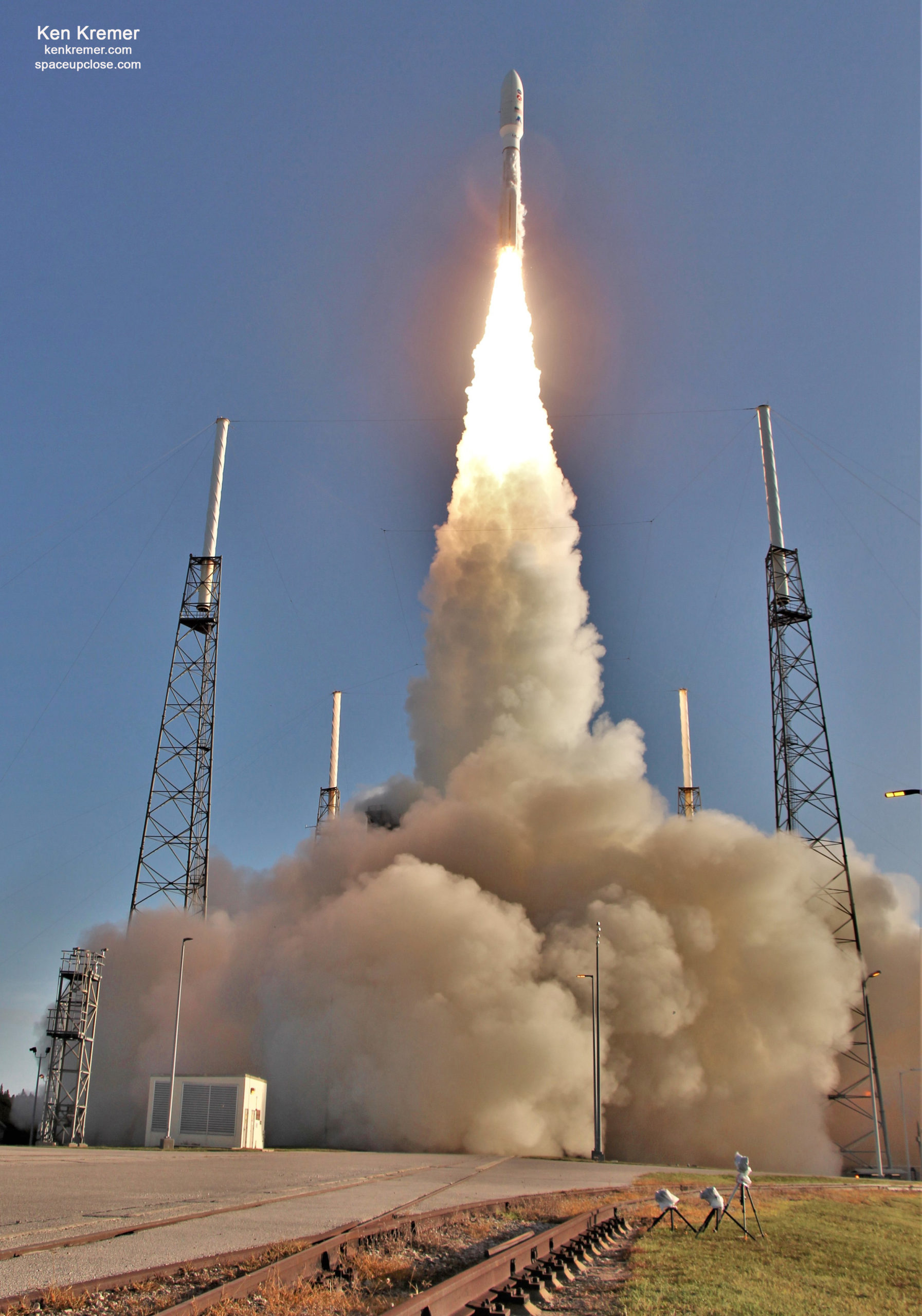
The SRBs successfully jettisoned at 1 minute 49 seconds after liftoff and the payload fairing at 3 minutes 29 seconds.
The RL10C-1 engine powers the Centaur upper stage fueled by LOX and liquid hydrogen (LH2) producing 22,900 pounds of thrust. The Centaur successfully fired twice at 4 minutes and 45 minutes after liftoff to put Perseverance on course for Mars after separating at 57 minutes after liftoff
Watch this cool ULA video from a rocket mounted camera:
“#MarsPerseverance on its way to the Red Planet…” tweeted Tory Bruno.
https://x.com/torybruno/status/1288886632502956033
The spacecraft is healthy and power positive, reports NASA.
It had briefly entered safe mode likely “because a part of the spacecraft was a little colder than expected while Mars 2020 was in Earth’s shadow.” But has since exited and is sending good telemetry back to Earth.
“I now have good signal strength with my team back on Earth. They’re tracking my location and will keep talking to me as I cruise to Mars. go.nasa.gov/3ggbNGu #CountdownToMars,” tweeted the rover.
“Update on @NASAPersevere: We have received telemetry (detailed spacecraft data) down from the spacecraft and have also been able to send commands up to the spacecraft. Perseverance is healthy and on its way to Mars,” tweeted Bridenstine.
https://x.com/NASAPersevere/status/1288978403161288704
Back in 2011, the ULA Atlas V 541 rocket launched NASA’s older sister rover Curiosity on its 10-month, 354 million-mile journey to the surface of Mars.
Overall Perseverance is the 5th rover NASA has sent to Mars and will be the 9th mission to land on the Red Planet if all goes well.
“There is still a lot of road between us and Mars,” said John McNamee, Mars 2020 project manager at JPL, in a statement.
“About 290 million miles of them. But if there was ever a team that could make it happen, it is this one. We are going to Jezero Crater. We will see you there Feb. 18, 2021.”
After a seven-month-long 314 million miles (505 million kilometers) interplanetary journey Perseverance is scheduled to touch down in an area of Mars known as Jezero Crater on Feb. 18, 2021.
The 28-mile-wide (45-kilometer) crater is home to an ancient dried-up river delta and a lake that once filled it.
“Jezero Crater is the perfect place to search for signs of ancient life,” said Thomas Zurbuchen, associate administrator for NASA’s Science Mission Directorate at the agency’s headquarters in Washington.
“Perseverance is going to make discoveries that cause us to rethink our questions about what Mars was like and how we understand it today. As our instruments investigate rocks along an ancient lake bottom and select samples to return to Earth, we may very well be reaching back in time to get the information scientists need to say that life has existed elsewhere in the universe.”
https://x.com/NASA/status/1288872395407843328
The one-ton rover will spend at least one Mars year (two Earth years) exploring the landing site region. The rover is equipped with seven different scientific instruments and the mission includes 25 cameras – the most ever to Mars and deep space. The rover itself is equipped with 19 cameras.
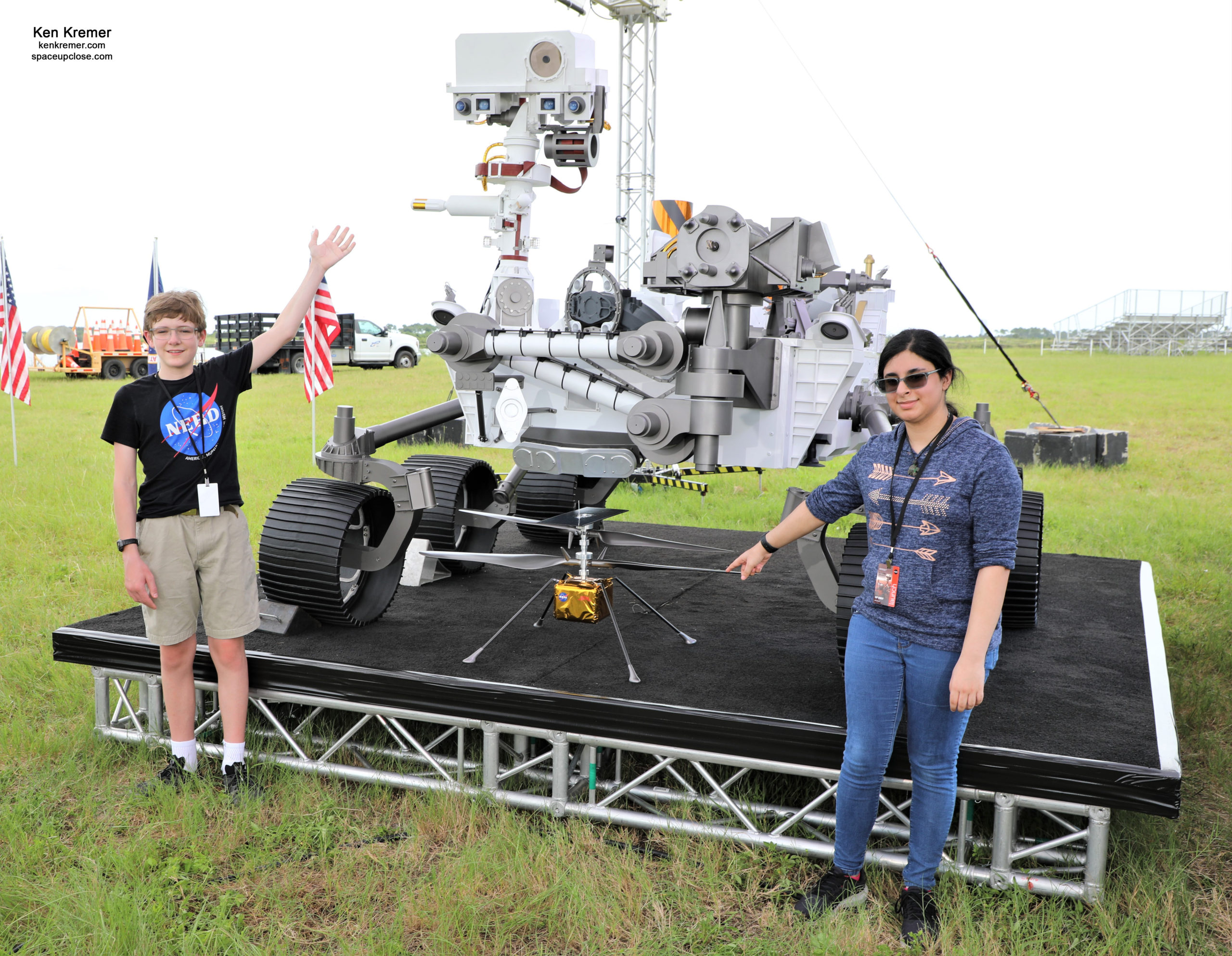
The solar-powered Ingenuity helicopter is a technology demonstration experiment aimed at attempting the first flight on Mars.
The four-legged Ingenuity has a mass of about 4.0 pounds (1.8 kilograms) and stands 1.6 feet or 19 inches (0.49 meters) high. It is equipped with two counter-rotating blades for lift spinning at about 2,400 rpm and two cameras.
ULA and its heritage rockets have launched every U.S. led mission to Mars, beginning in the 1960s, explains ULA CEO Tory Bruno with great pride.
To date, ULA has now launched its 20th trip to the red planet, the 85th successful launch of an Atlas V rocket, and the 140th successful ULA launch across all its rocket families.
The Atlas V has previously launched four missions to Mars, including the Mars Reconnaissance Orbiter in 2005, the Curiosity rover in 2011, the MAVEN orbiter in 2013 and the InSight lander in 2018.
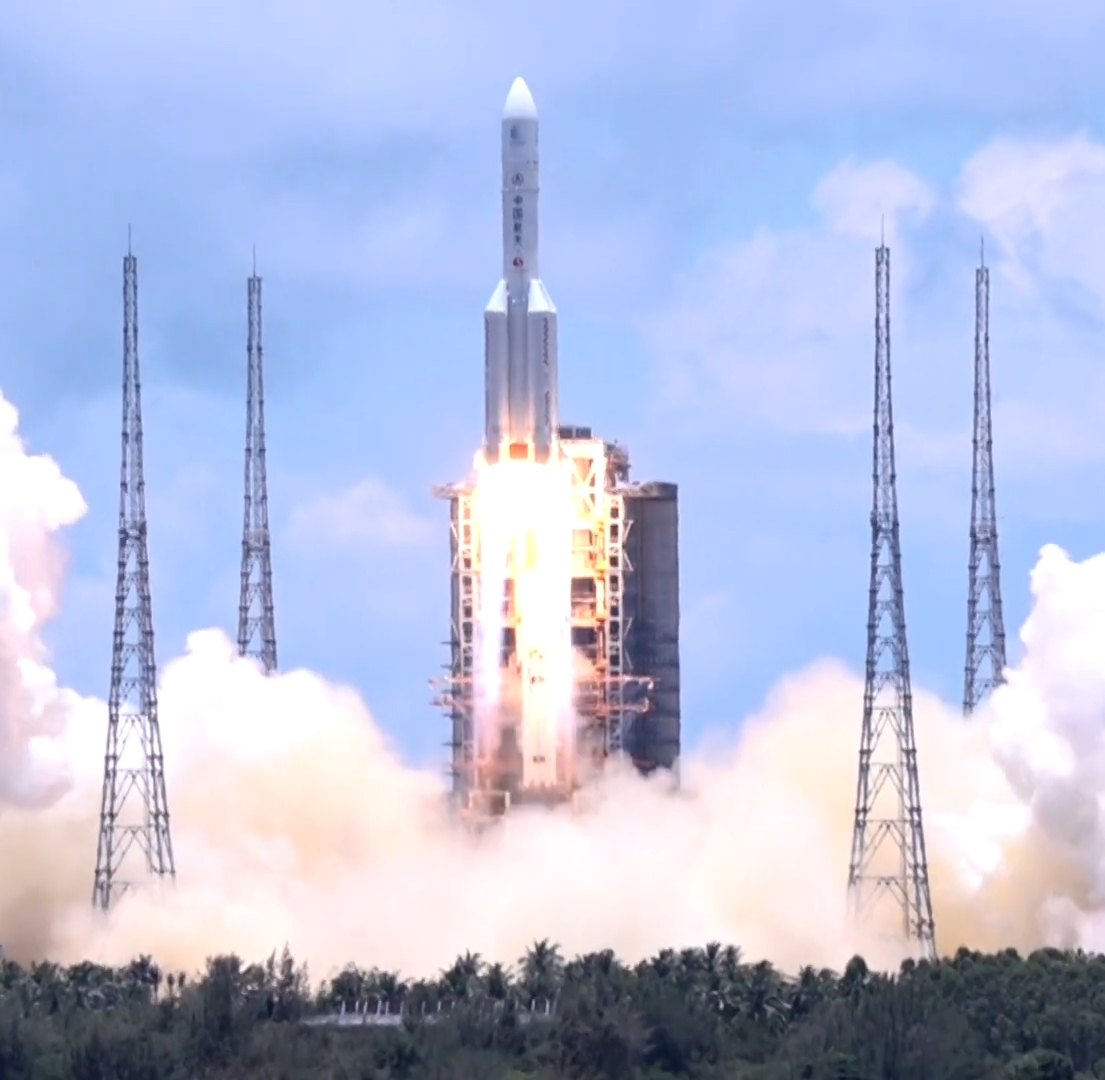
China launches ambitious Tianwen-1 mission with orbiter, lander & rover
China has successfully launched its first fully indigenous mission to Mars – the extremely ambitious Tianwen-1 robotic mission designed to orbit, land and rove on the Red Planet – aimed at comprehensively investigating its climate, atmosphere and geology and search for signatures of water as well as snapping numerous images.
China utilized its most powerful rocket – the relatively new heavy-lift Long March 5 – to hurl the combination Tianwen-1 orbiter and lander mission to Mars.
The Chinese Tianwen-1 spacecraft lifted off atop the Long March 5 carrier rocket from the seaside Wenchang Space Launch Center in southern China’s Hainan province on Thursday, July 23, at 12:41 a.m. EDT (0441 GMT; 12:41 p.m. Beijing time).
The 11,000-pound (5-metric ton) Tianwen-1 probe was injected directly into the Earth-Mars transfer orbit and is now in transit for a seven-month-long interplanetary journey to the Red Planet. The probe will arrive in February 2021.
If successful China will become only the third nation to land a spacecraft on Mars.
Overall this was the fifth launch of Long March 5 – counting four successes and one failure on the second launch.
The Long March 5 rocket stands 187-feet (57-meters) tall. The probe was released about 36 minutes after liftoff
But the exact launch date and time were shrouded in mystery by the Chinese government and not announced ahead of Thursday’s blastoff by Chinese state media.
And China’s official state media did not broadcast the mission live on TV. They did however put warning notices for airspace and mariners for Thursday to avoid the path of the potential Long March 5 rocket on Thursday.
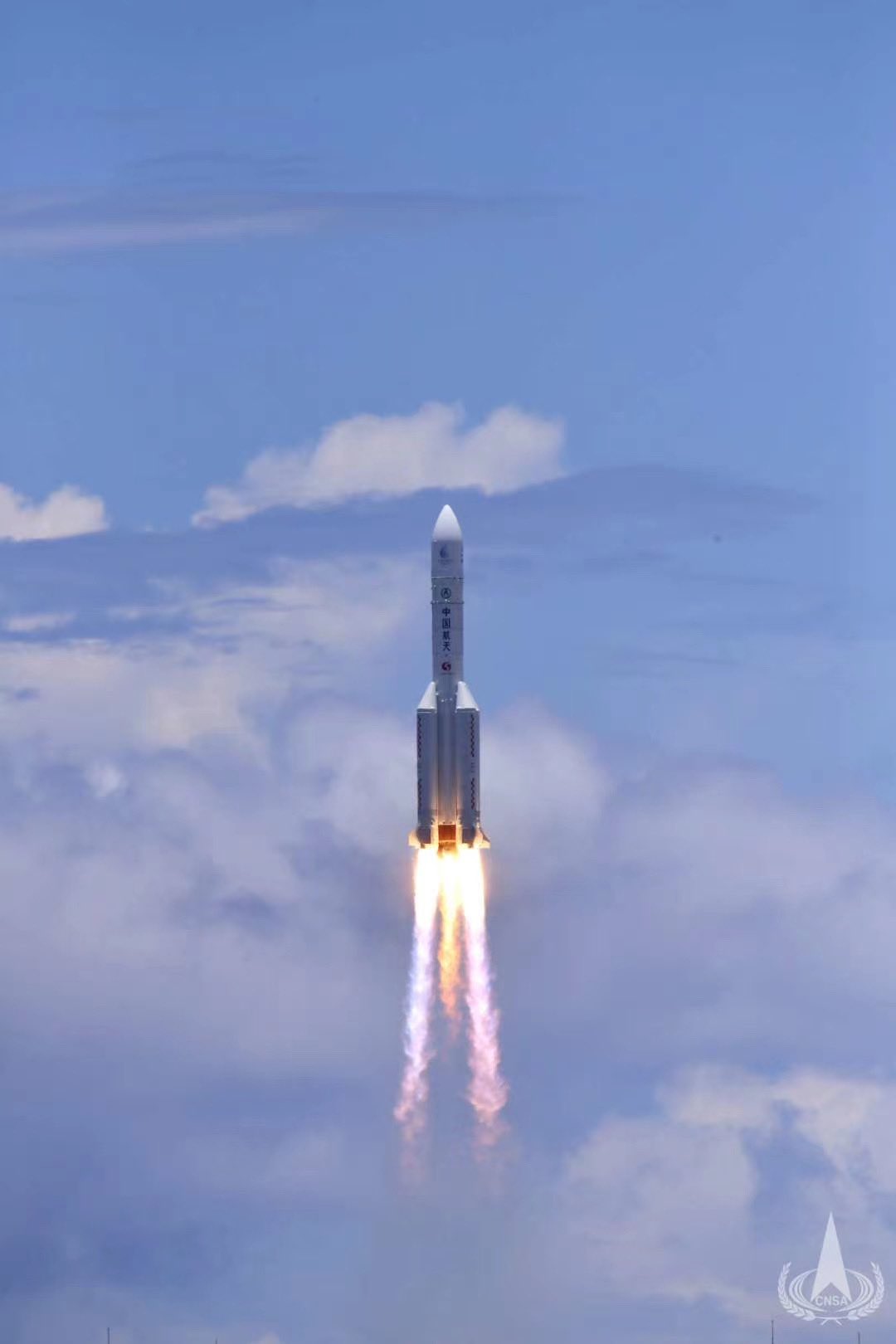
The mission was developed, directed, and funded by China’s national space agency – namely the China National Space Administration (CNSA).
“China’s first Mars mission is named Tianwen-1 and aims to complete orbiting, landing and roving in one mission,” according to the mission team led by Wan Weixing, chief scientist of China’s Mars exploration program, in a paper just published this month days before liftoff by the science journal Nature Astronomy.
“The name means ‘questions to heaven’, taken from the name of a poem by Qu Yuan (about 340–278 BC), one of the greatest poets in ancient China.”
Wan died in May after a long illness.
“The country’s first Martian probe will conduct scientific investigations about the Martian soil, geological structure, environment, atmosphere, as well as water,” CNSA said in a statement.
NASA Administrator Jim Bridenstine quickly offered congratulations:
https://x.com/JimBridenstine/status/1286177196491575297
Tianwen-1 thus becomes the second of three missions launching from Earth to Mars during this limited 2020 launch season when the orbits of the two planets align favorably for launch.
Altogether there are 13 science instruments included on the Tianwen-1 mission – seven on the orbiter and six on the rover/lander including cameras, spectrometers, ground-penetrating radar
The prime landing site for the 529 pounds (240 kg) solar-powered rover is in Utopia Planitia which will descend to the surface for a soft landing using parachutes, retrorockets, and airbags – EDL similar to NASA’s landers and rovers.
The Mars rover has about twice the mass of China’s Yutu moon rovers.
After entering polar elliptical orbit in February 2021 ranging between 165 miles (265 kilometers) and nearly 7,500 miles (12,000 kilometers) the orbiter will deploy the rover/lander around two months later in April 2021.
If all goes well the lander will then release the rover which will drive down a pair of tracks to the Martian surface – similar to how China’s two Yutu rovers drove onto the lunar surface.
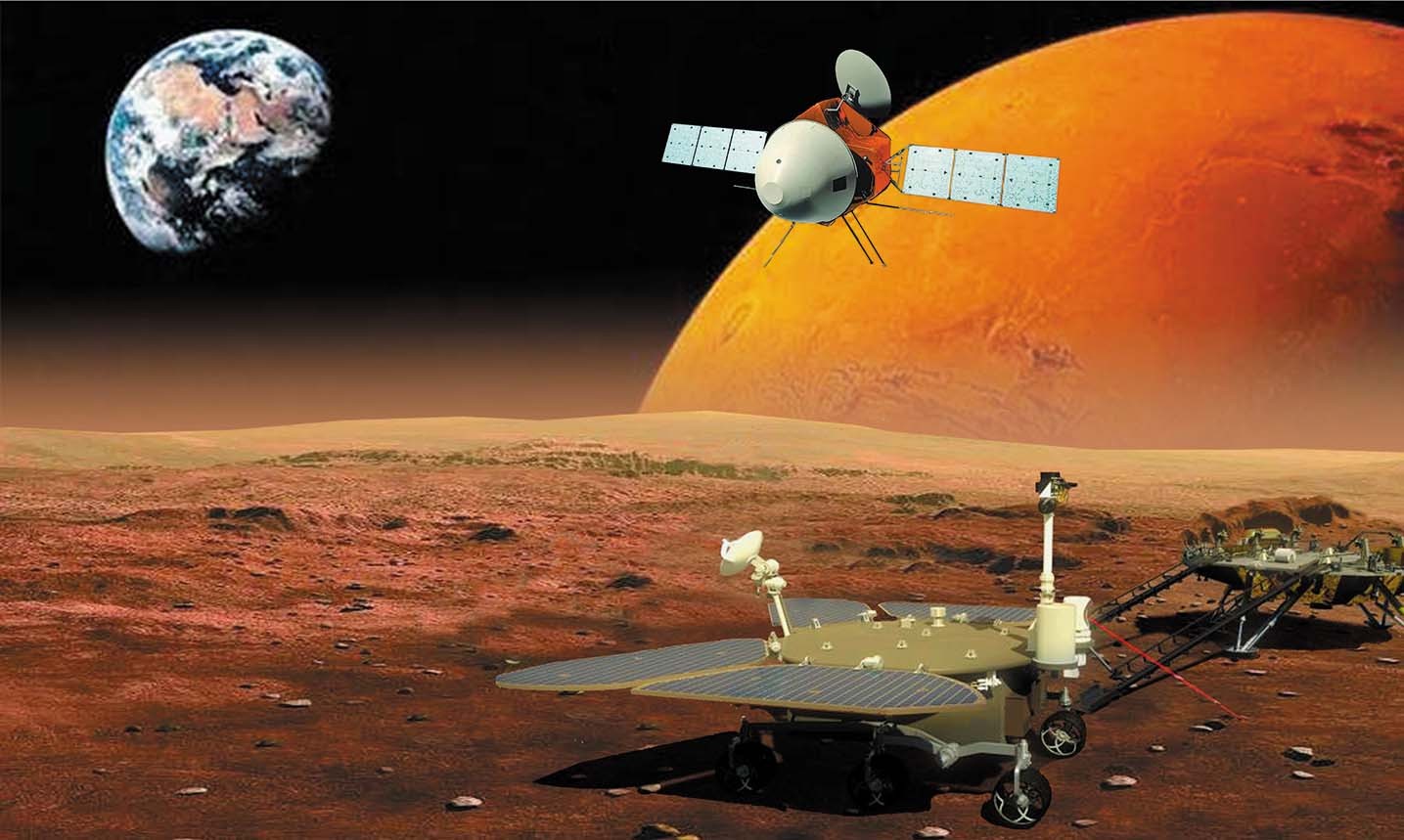
The six-wheeled rover is expected to last about 90 days and looks a lot like NASA’s Mars Exploration Rovers’ Spirit and Opportunity.
The orbiter will operate at least one Martian or two Earth years.
Here are further details about Tianwen-1 from the mission team paper:
The Tianwen-1 probe, with a mass (including fuel) of about 5 tonnes, comprises an orbiter and a lander/rover composite. The orbiter will provide a relay communication link to the rover while performing its own scientific observations for one Martian year.
The orbit during the scientific observation stage is a polar elliptical orbit (265 km × 12,000 km).
The lander/rover will perform a soft landing on the Martian surface some 2–3 months after the arrival of the spacecraft, with a candidate landing site in Utopia Planitia.
The ~240 kg solar-powered rover is near twice the mass of China’s Yutu lunar rovers and is expected to be in operation for about 90 Martian days.
The main task of Tianwen-1 is to perform a global and extensive survey of the entire planet using the orbiter and to send the rover to surface locations of scientific interests to conduct detailed investigations with high accuracy and resolution.
Specifically, the scientific objectives of Tianwen-1 include: (1) to map the morphology and geological structure, (2) to investigate the surface soil characteristics and water-ice distribution, (3) to analyze the surface material composition, (4) to measure the ionosphere and the characteristics of the Martian climate and environment at the surface, and (5) to perceive the physical fields (electromagnetic, gravitational) and internal structure of Mars.
There are 13 scientific payloads in the Tianwen-1 mission in total.
The seven instruments onboard the orbiter comprise two cameras, the Mars-Orbiting Subsurface Exploration Radar, Mars Mineralogy Spectrometer, Mars Magnetometer, Mars Ion and Neutral Particle Analyzer, and Mars Energetic Particle Analyzer.
The six instruments installed on the rover comprise the Multispectral Camera, Terrain Camera, Mars-Rover Subsurface Exploration Radar, Mars Surface Composition Detector, Mars Magnetic Field Detector, and Mars Meteorology Monitor.
Tianwen-1 is going to orbit, land and release a rover all on the very first try, and coordinate observations with an orbiter. No planetary missions have ever been implemented in this way.
If successful, it would signify a major technical breakthrough. Scientifically, Tianwen-1 is the most comprehensive mission to investigate the Martian morphology, geology, mineralogy, space environment, and soil and water-ice distribution.
The Tianwen-1 probe is expected to reach Mars around February 2021 and the scientific observation phase will start in April 2021.
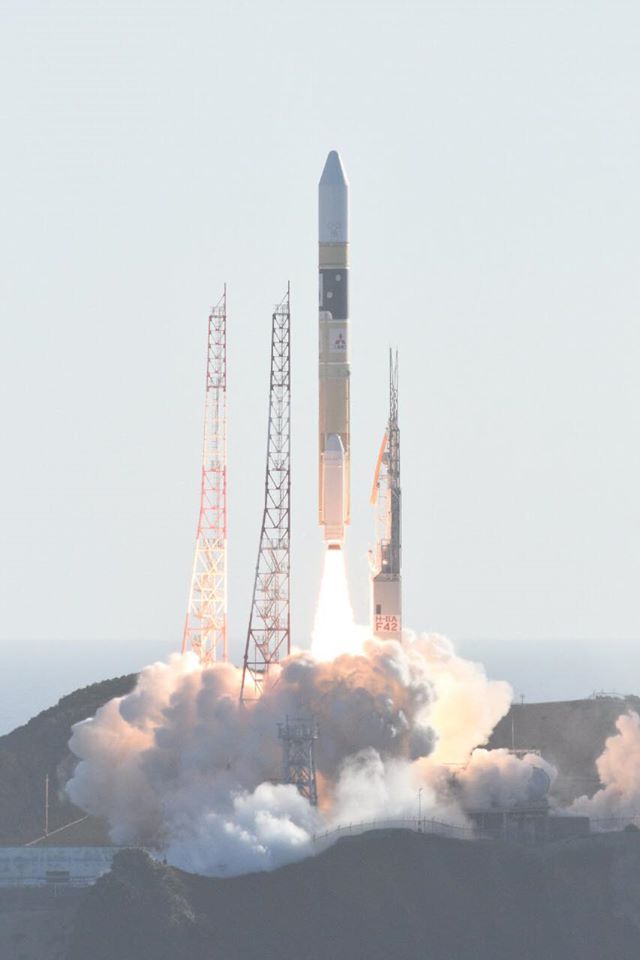
Hope is historic first Emirates mission to Mars
Hope – the history-making first Emirates mission to Mars was hurled skywards Sunday, July 19, 2020, on a Japanese rocket to begin a seven-month interplanetary journey bound for the Red Planet. The orbiter is designed to study the planet’s weather and climate, to build a foundation for the nation’s burgeoning space program, and inspire the nation’s young people to study science.
Launch of the Hope Mars Mission on the Japanese H-2A rocket took place as scheduled, Sunday, July 19, US time at 5:58:14 p.m. EDT (2158:14 GMT), or Monday, July 20th, 2020 at 01:58 am UAE local time, 6:58 a.m. Japan Standard Time from Launch Pad No. 1 at the Yoshinobu launch complex located at the Tanegashima Space Center.
“The Emirates Mars Mission (EMM), the first interplanetary mission undertaken by an Arab nation, has successfully launched the Mars Hope probe from the Tanegashima Space Center in Kagoshima Prefecture, southwestern Japan at 01:58 am UAE Time,’ said the UAE space agency.
https://x.com/MHI_LS/status/1284978098757234688
‘A New Hope’ is how some dubbed the mission sponsored by the government of the United Arab Emirates (UAE) that finally lifted off after a series of weather delays postponed the mission.
Congratulations came quickly from around the world including from NASA Administrator Jim Bridenstine.
https://x.com/JimBridenstine/status/1284996702181765125
“Following lift off from the launch platform, a two-stage 53-meter Mitsubishi MHI-2A reached a velocity of 38,000 km/h (Mach 35) to place the probe into earth’s orbit,” reported the UAE Mohammed bin Rashid Space Centre (MBRSC).
“The probe now commences a 493,000,000 Km journey to reach and orbit the Red Planet, with MOI (Mars Orbit Insertion) due to take place in February 2021.”
Hope aims to build the first full picture of Mars’ climate throughout the Martian year.
“This has been a defining moment on our six-year journey to build and launch Mars Hope,” said Omran Sharaf, EMM Project Director at the Mohammed bin Rashid Space Centre.
The Hope Mars Mission began in 2014.
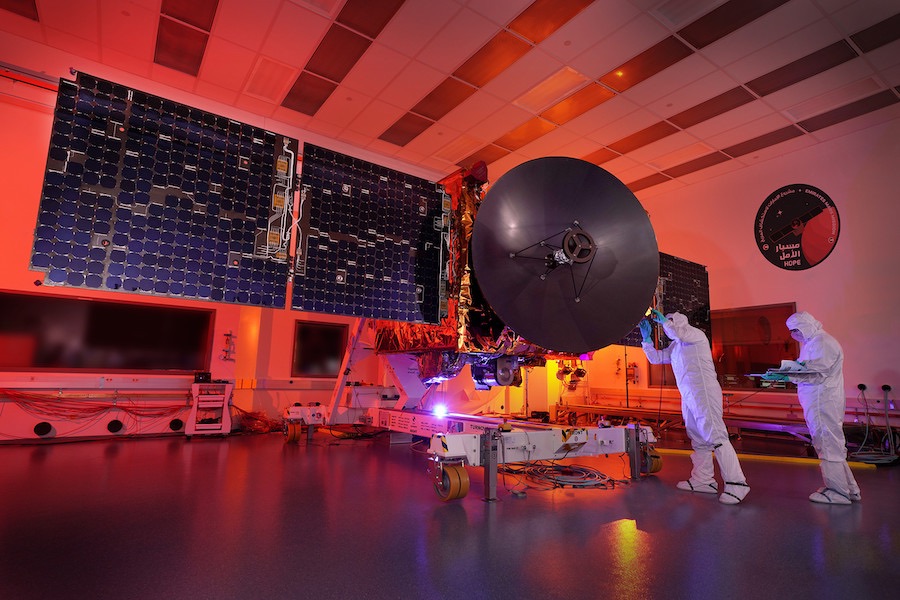
“The team at MBRSC is delighted and celebrating, obviously, but there’s a lot of work yet to go. We’re in the Launch and Early Operations (LEOP) phase of the mission and commencing our seven-month cruise to Mars. The Hope probe has performed perfectly so far and we’re in great shape.”
Hope’s mission is focused on atmospheric dynamics. It will explore the atmosphere of Mars globally while sampling both diurnal (daily) and seasonal timescales, a unique feat for any Mars mission. Hope will support the first complete picture of Mars’ weather and for the first time, scientists in over 200 universities and institutes globally will have access to a holistic view of the Martian atmosphere at different times of the day, through different seasons.
If all goes well the Hope Mars Orbiter will be the first mission from the Arab world to orbit another planet.
EMM or Hope is funded by the UAE Space Agency and The Mohammed Bin Rashid Space Centre to the tune of about $200 million.
In addition to the science, another goal is to “Get a probe to Mars by the Emirates’ 50th anniversary in 2021.”
The Mini Cooper sized probe has a mass of approximately 2,976-pound (1,350-kilogram).
After a seven-month 493,500,000 km interplanetary journey the EMM Hope Mars Orbiter will arrive at the Red Planet in Feb. 2021.
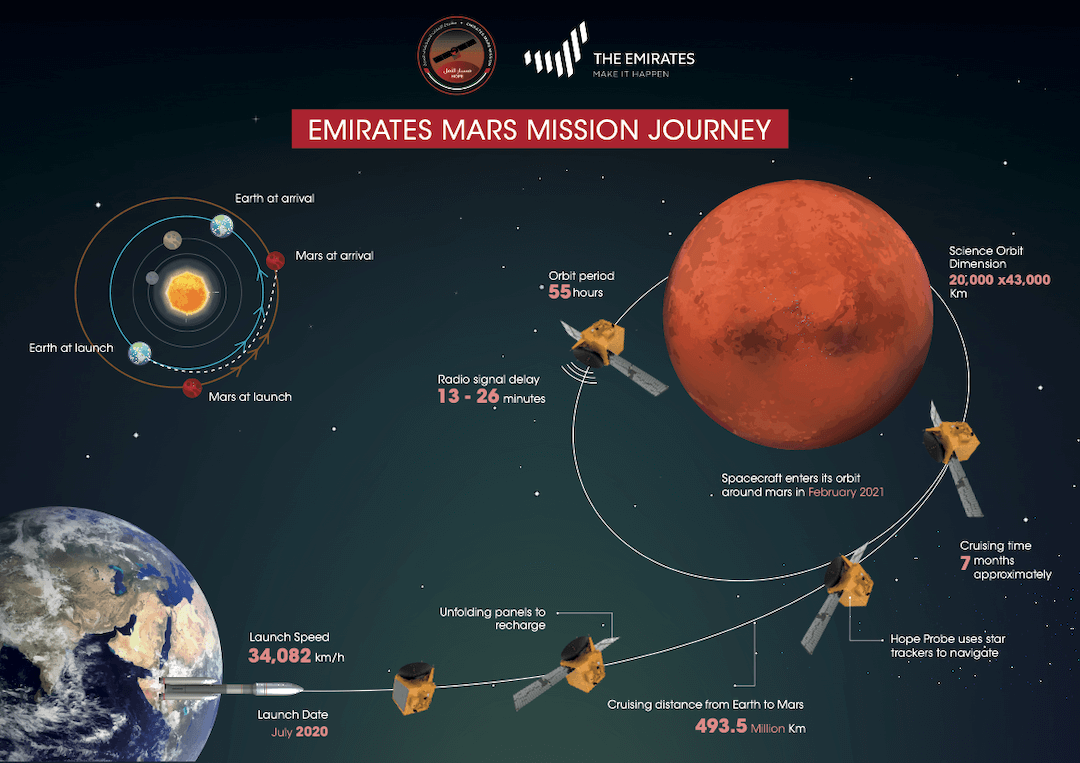
Science Goals:
Hope’s mission is focused on atmospheric dynamics. It will explore the atmosphere of Mars globally while sampling both diurnal (daily) and seasonal timescales. (Never been done by any previous Mars mission). Understanding atmospheres of other planets, allows us to better understand our planet (since there is another sample to compare with) and better understand other planets in the universe.
Hope is equipped with three science instruments:
EXI – The Emirates eXploration Imager is a digital camera that will capture high-resolution images of Mars along with measuring water ice and ozone in the lower atmosphere through the UV bands.
EMIRS – The Emirates Mars InfraRed Spectrometer will measure the global distribution of dust, ice cloud, and water vapor in the Martian lower atmosphere.
EMUS – The Emirates Mars Ultraviolet Spectrometer will measure oxygen and carbon monoxide in the thermosphere and the variability of hydrogen and oxygen in the upper atmosphere.
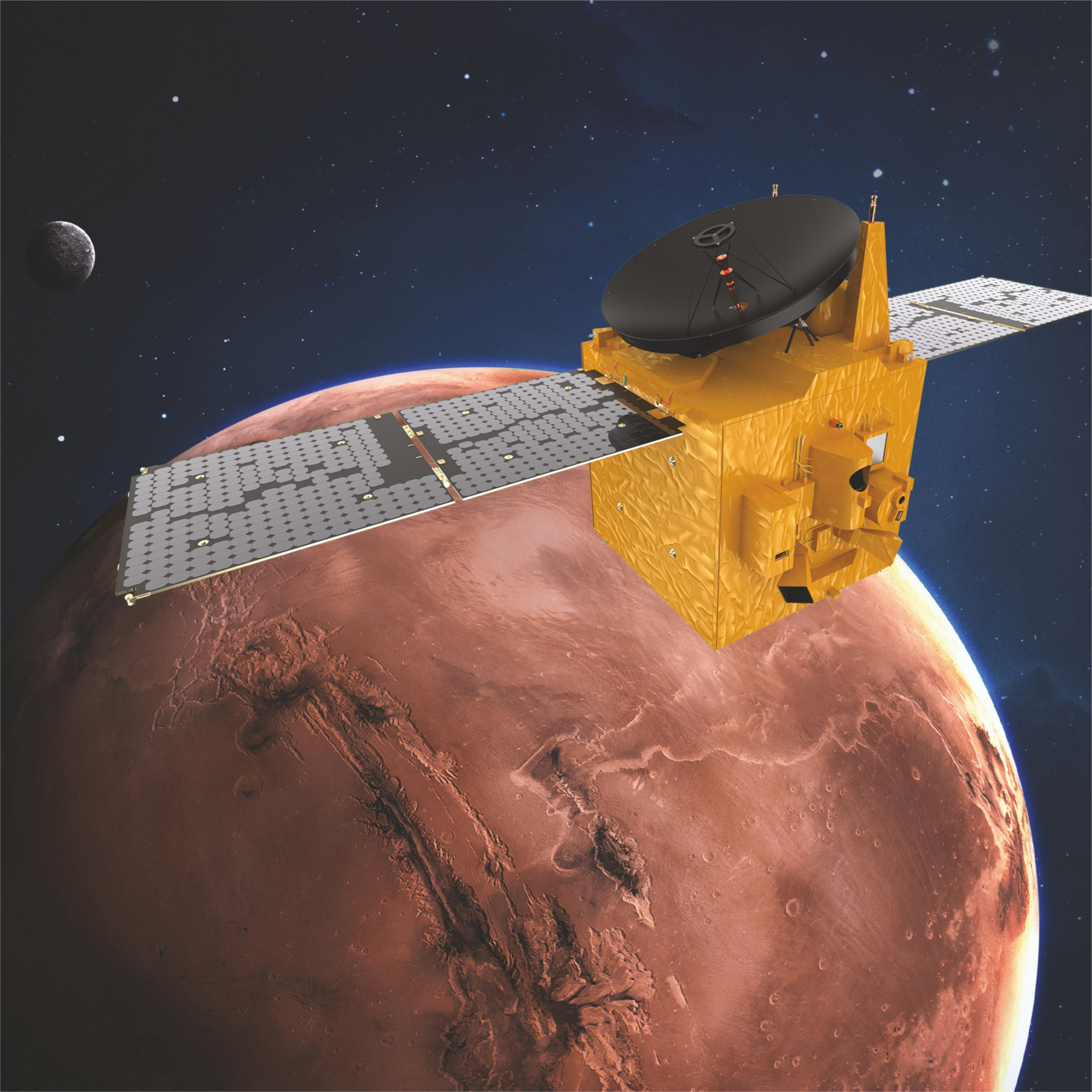
Partners on the EMM team:
The Hope Probe was designed and developed by the EMM team at MBRSC together with Knowledge Transfer partners at the University of Colorado, Boulder; Arizona State University, and the University of California, Berkley.
- The Laboratory for Atmospheric and Space Physics (LASP) at University of Colorado, Boulder is the primary knowledge transfer partner for mission design, spacecraft, and EXI/EMUS instrument development, testing, science team/apprenticeship, and operations.
- Arizona State University is the knowledge transfer partner for EMIRS instrument development and science team/apprenticeship.
- The University of California, Berkeley Space Sciences Lab (SSL) is the knowledge transfer partner for Science team/apprenticeship & EMUS detectors.



